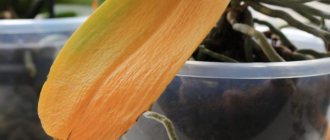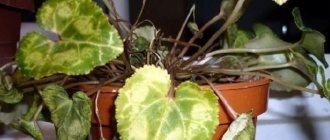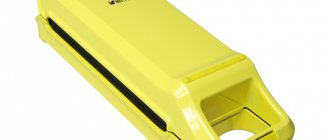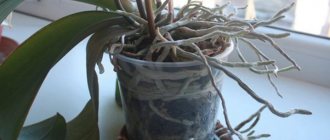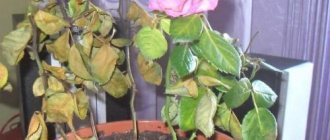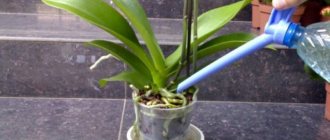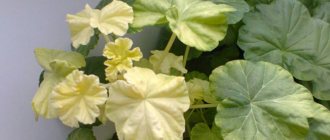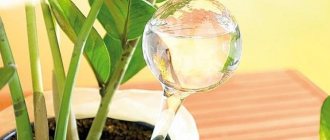Aloe is a frequent visitor to city apartments. This is not surprising, because agave belongs to that rare category of plants that are very difficult to destroy. However, sometimes “force majeure” situations happen to him.
We are accustomed to considering aloe as a crop that is almost impossible to harm. And yet, sometimes even such an unpretentious plant can fall ill. Yellowing of leaves is perhaps the most common problem faced by gardeners who grow agave on their windowsill.
In our area, aloe vera is most often grown - a branched multi-stemmed succulent with narrow jagged leaves. At the same time, in the West, aloe vera, a close relative of the well-known agave, is more popular.
These plants differ in their structure. Aloe vera has leaves that grow directly from the root, while tree aloe has leaves attached to the stem. In addition, the leaf blades of aloe vera are much wider and fleshier, and the serrations on them are slightly smaller. However, these plants are cared for almost the same way.
Let's look at the most common reasons why leaves of different types of aloe may begin to turn yellow.
Excess light
Aloe is very undemanding when it comes to location, but that doesn't mean you don't need to consider its lighting needs. Despite the fact that in nature these plants live in deserts under the scorching rays of the sun, at home in extreme heat they will require shading.
For most of the year, in our area the sun is not as active as in the historical homeland of the agave. And since the plant has managed to adapt to precisely this “gentle” insolation regime, direct sunlight can be destructive for it.
It is especially important to monitor the plant from October to March. At this time, all biological processes that occur in aloe slow down significantly. A hibernating plant will not be able to cope with the active winter sun, so the plant may need additional shading.
Yellowness at the base
There is only one explanation for such a negative process - the soil is too waterlogged. Very often, due to constant waterlogging of the soil, rhizomes begin to rot. This leads to the appearance of root rot. This disease gradually rises from the roots to the base of the plant and, if the aloe disease is not overcome in time, it may die completely.
How to fix the situation?
You need to remove the flower from the flowerpot, clean the roots from the soil and remove all rotten areas.- It is also necessary to cut off all damaged parts on the stem before a healthy layer appears.
- Afterwards, all cut parts need to be washed, dried and sprinkled with crushed coal.
- Let the flower brew for several hours and only after that the aloe is planted in the pot.
The container for the flower should be small. At first, you need to water rarely and only through a tray until the perennial adapts.
You will find more information on what to do if medicinal aloe in a pot rots, withers and disappears here.
Temperature violation
The optimal air temperature for tree aloe, regardless of the time of year, is 23-25°C, while the plant can feel great even at lower temperatures. However, there is a condition - the air temperature must decrease gradually.
A sharp cold snap with a temperature drop of 10°C will definitely make itself felt. However, prolonged exposure to direct sunlight in hot weather (above 29°C) will also manifest itself.
Most often, agave plants, which are placed on a glassed-in loggia or balcony during the spring and summer, suffer from sudden changes in temperature. Therefore, it is very important to monitor weather forecasts and, depending on the situation, shade or take the plant indoors.
Aloe pests as a cause of yellowing and drying of leaves
What to do when the tips of dracaena leaves dry out
Aloe leaves can also dry out and turn yellow as a result of pest damage. This can be determined by careful examination of the aboveground part of the plant.
Damage to aloe by scale insects
Possible problems:
- Spider mite. The small insect is difficult to see with the naked eye. The lesion can be identified by the presence of small light dots along the edge of the leaf blade. Subsequently, a thin cobweb also appears on the leaves and stems.
- Thrips. The pest feeds on the sap of the plant, thereby weakening it. The lesion is identified by the presence of black spots on the leaves. In this case, the plates become yellow and deformed.
- Mealybug. The pest is a white insect. When there is a massive accumulation, a cotton-like coating is noticeable on the leaves. It multiplies in the top layer of soil and then spreads to the leaves and stem of aloe.
- Shield. The pest looks like small, immovable plaques that can be removed with a fingernail. Initially localized along the main stem, and then switches to the leaves. Yellow spots appear in these places.
If there is a small cluster of pests, you can wash the aloe leaves with soap or garlic solution. In case of mass damage, chemical agents are used: Actellik, Fitoverm, Fufanon. The gardener decides which one to choose, depending on the complexity of the situation.
Additional Information! Treatment of the above-ground part should be carried out 2-3 times at intervals of 5-7 days, alternating preparations. In the case of scale insects, the plant is additionally watered with Aktara’s working solution.
Wrong substrate
Like the vast majority of succulents, aloe prefers light and loose soil, preferably with weak acidity, although the plant will like neutral values.
Substrate for aloe: 2 parts leaf soil, 1 part baking powder (perlite, vermiculite, river sand), 1 part humus. The soil is laid in layers - at the bottom there is a 2-3 cm layer of drainage, followed by a substrate, and on top of the “trunk circle” of aloe is mulched with sand, fine gravel, perlite or vermiculite.
How to properly care for a plant at home?
Caring for aloe is quite simple, you need to know 5 simple rules:
- Place and light. Any window sill will do, the main thing is to avoid direct sunlight. In winter, additional lighting is required.
- The soil. It should be slightly acidic, loose and with high air permeability.
- Lure. Fertilizers are added during the plant growth period no more than once every 2 weeks. In winter, the plant takes a break from feeding.
- Hydration. In summer, at least once every two weeks, more often when the soil dries out completely. In winter - once a month.
- Prevention of parasites and diseases. A weekly inspection for their presence is required. Every 3-4 days, wipe the leaves and ventilate the room well.
Caring for aloe is quite easy, but without meeting all the conditions for its maintenance, the plant will not be able to fully live and develop. It is optimal to devote at least half an hour a week to the agave, and then the flower will delight its owner with its aesthetic and medicinal properties.
Failure to adhere to the watering schedule
The leaves of a plant can turn yellow either from a lack or from an excess of water. But how can you tell whether a plant needs more or less fluid?
The easiest way to check if a plant has enough water is to “test” the soil with a wooden stick. If the soil is dry, “water” the aloe, but do it without fanaticism - the plant needs a little time to recover.
If you are unable to determine the degree of moisture in the substrate using available means, take a close look at the leaves of the plants. In “under-watered” aloe, they are noticeably thinner and yellower than in healthy plants, while in over-watered ones the leaves are more brownish than yellow. Turgor can remain quite elastic.
Disease Prevention
The cause of diseases such as root and dry rot is improper care of aloe, incorrectly selected soil or violation of the watering regime.
Root rot threatens succulents planted in heavy soil. Because it retains moisture. If such a plant is watered irregularly, a crust forms on the soil surface that does not allow oxygen to pass through. This causes acidification of the soil and creates favorable conditions for the proliferation of pathogens that destroy the roots.
Dry rot appears if the pot has very light soil and practically no moisture is retained. The roots of the plant do not receive enough liquid to nourish the trunk and leaves, and constant stress weakens the aloe. As a result, the flower is unable to resist the fungus that has begun to develop in the trunk and leaves and destroys every cell of the plant.
Attention! The natural environment of aloe is hot countries, where on light, well-ventilated, moist soils it reaches gigantic sizes. This should not be forgotten when deciding to purchase a healing flower for an apartment.
If on top of everything else, aloe is forced to survive in a small pot, where the roots are cramped and the cuttings have nowhere to take root. At the same time, it has not been transplanted for years, then diseases are simply inevitable.
Lack of space
Once the aloe has settled down well after being transplanted into a new pot, it immediately begins to produce numerous side shoots. At some point, the plant’s stems no longer have enough space outside the pot, and its roots become cramped inside. The aloe root system fills all the free space, which is why the agave begins to experience a shortage of water and nutrients and gradually dries out. However, some shoots may look quite healthy.
Cut out “extra” side shoots in a timely manner, regularly divide and replant the agave into larger containers.
Yellow spots all over the leaf
Pigmentation on leaf blades of aloe is observed for a number of reasons:
- Lack of moisture in the soil - most likely you moisten the soil too rarely or the room is too hot, causing the substrate to dry out quickly.
Important! Dry soil is considered an ideal habitat for various pests. - Development of fungal infections. Often in such cases, areas of the leaves not only turn yellow, but also become soft and lifeless. To rid the plant of fungus, you need to treat the aloe with a soap solution. If such manipulation does not help, then you should turn to antifungal drugs.
- The plant may become covered with yellow spots even due to the fact that it is rarely dusted. This should be done with a regular cloth soaked in clean water, and once a month you can wipe the surface of the flower with a swab dipped in an alcohol solution. This will be an excellent prevention of the development of various diseases.
You can learn more about the causes of problems with aloe leaves, as well as ways to solve them, in this article, and here we talked about why the plant dries out and how to save it.
Disease
Densified plantings, non-compliance with the watering schedule and constant stress lead to the fact that rot begins to develop on the plant.
Dry rot develops very quickly and almost always leads to the death of the plant. First, the tips of medium-sized, fairly developed leaves dry out. Then the disease spreads to the central part of the leaf blade. The dead leaf dries out and curls, and the rot spreads to the adjacent stem.
Aloe dies from the inside, so you can save the plant only if you immediately separate healthy cuttings from the agave for further rooting. Even if you divide the plant, remove the affected trunks, and transplant the healthy parts of the plant into a new substrate, having previously treated the roots with a biofungicide, for example, Alirin or Glyocladin, this will not give a 100% guarantee.
With root rot, aloe leaves become thinner and more watery, quickly wither and fall off. The color of the leaf blades changes from green to yellow. The stems become fragile and break off easily, and an unpleasant odor emanates from the plant. If you suspect root rot in your aloe, remove the centenarians from the pot and carefully inspect the roots. Cut out the affected parts of the plant, separate the healthy parts and replant (if a healthy part of the root remains) or root.
- Aloe: how to grow and use
The beneficial properties of aloe have been known for more than three thousand years. Find out how to grow and use it at home.
Why does yellow color appear on the tips of leaves?
There may be several reasons why the ends of leaf blades turn yellow. The most common of them:
- incorrect light mode;
- excessive soil moisture;
- rotting of the root system;
- unsuitable soil mixture;
- diseases and pests.
How to treat at home?
- Lighting . Aloe loves light, but everything is good in moderation. The room in which the pot with the plant is located should be well lit, but this light should not be direct - make sure that the rays of light are scattered. But you should not overdo it with protecting the flower from light, since due to a lack of light, the tips of aloe leaves may also turn yellow.
Choose the correct watering mode . In this case, it is also good to maintain moderation. The substrate should not be dry. To properly water aloe, you need to adhere to the following rules:- Once again, you can moisten the soil only when the soil dries out and remains in this state for at least a day;
- if you spray the air around the plants, you need to reduce the amount and frequency of watering.
- Selection of soil mixture . The soil in the flowerpot should be kept moist almost all the time. You need to make sure that the soil is loosened. When choosing soil in a store, you need to pay attention to its acidity.
- Diseases and pests . Typically, yellowing of the tips of leaf blades is caused by an attack by spider mites. It is easy to notice thanks to the web formed on the surface of the plant. However, such obvious signs will appear only when the flower begins to die. Therefore, in order to prevent the development of parasites on aloe, it must be carefully inspected regularly and hygienic procedures must be carried out: wipe the leaves from dust and wash the entire plant in the shower. You need to fight spider mites with acaricidal drugs.
Video about the fight against yellowed aloe leaves:
Incorrect organization of fertilizing
It’s not enough to just buy the “right” fertilizer for the plant; you also need to know how to apply fertilizer without harming the plant. A few simple rules:
Never feed a plant while it is sick. Do not rush to feed new and recently transplanted plants. In the latter case, it will be much more beneficial for aloe if you treat the roots with a growth stimulator (Kornevin, Heteroauxin) before planting. Make sure that the fertilizer does not get on the trunk or leaf blades of the plant. Fertilize in cloudy weather (to avoid burns if the solution gets on parts of the plant). It is advisable to start in the morning so that by night the top layer of soil has time to dry out at least a little.
If you notice yellow, orange or reddish spots on the leaves of aloe, remember the last time you fed not only the agave, but also other inhabitants of the windowsill. Perhaps, in the process of foliar feeding a neighboring plant, you accidentally got droplets of fertilizer on the aloe, which is why burns appeared on it.
For many people, agave is not only an unpretentious houseplant, but also a valuable raw material for the preparation of growth stimulants or agents for the treatment of various diseases, for example, peeled agave leaf blades can be used to relieve sore throats with sore throat or pharyngitis.
Pests
@kursi-floristiki.ru
Pests that adversely affect the health of aloe are no less dangerous. The most common:
- Spider mite. Thin webs and yellowing leaves indicate mite infestation. The pest settles in a colony on the lower part of the leaf and sucks the juices from the plant. The aloe will soon die if no action is taken.
- Scale insect and false scale insect . Outwardly they look like whitish plaques on the surface of the leaf. In the process of life, the juices are sucked out of the aloe and lead to its gradual death.
- Mealybug . Visually it resembles a trunk covered with small pieces of wax. It is afraid of moisture, so in the initial stages of the lesion it is enough to treat it with a solution of alcohol or vinegar.
When to transplant?
It is recommended to replant young plants every year, old ones - once every couple of years. It is best to do this in March, when the agave is ready for active growth after the winter period.
For replanting, use a pot that is slightly larger in size than the old one. Drainage is poured at its bottom. Then - a small layer of soil, place the plant on it and continue to fill the pot. You can sprinkle a layer of small pebbles on top to avoid erosion of the soil and rotting of the roots.
Aloe leaves turn yellow - tips for proper care
Aloe or agave has become a traditional attribute of our windows. Many gardeners willingly grow this plant at home ; they choose it because of its versatility - its interesting appearance is combined with effective medicinal qualities. An indoor flower does not require much effort in care and usually does not upset its owners by deteriorating its condition, but you need to know the specifics of its cultivation. If you do not follow a few simple rules, yellowness may appear on the aloe leaves.
Causes of adverse plant changes
Experienced gardeners believe that aloe leaves have yellow leaves for the following reasons:
- improper lighting - the plant is harmed by its lack and excessive illumination of the place where the flower pot is installed;
- use of unfavorable temperature conditions;
- a consistently dry substrate or in cases where it is constantly waterlogged;
- placing a pot of agave in a draft;
- due to the process of rotting plant roots.
Helping your favorite plant: why does aloe turn yellow and what to do about it?
Aloe (also known as agave) has been a leader among gardeners' favorites for many years.
And this is not without reason. After all, such a plant is considered universal: it performs both an aesthetic and medicinal function. In addition, aloe is not particularly fussy to care for. This is another reason why perennials can be found in almost every home.
This article will describe the causes of yellowing of aloe parts, as well as ways to combat this problem.
What to do to prevent pests?
Preventing diseases and pests is much easier than fighting them and their consequences. To protect plants, you just need to carefully observe them, noting all changes. And also take precautions when replanting or the appearance of new “neighbors” on the windowsill. Replant, fertilize and process in a timely manner. Water on time and do not disturb the temperature regime.
It is worth adhering to these requirements when caring for the plant:
- When using old pots when replanting, gardeners should not forget to treat them with disinfectant compounds.
- When rooting new cuttings, be sure to choose a larger container. So that the roots have enough room to grow.
- The soil taken from the garden plot should be heated in the oven or poured with boiling water to destroy pests.
- Wipe the aloe leaves and inspect the trunk weekly. Thanks to this, you can not only notice warning signs in time, but also prevent the appearance of diseases and pests.
A strong, healthy plant can easily withstand both stress factors and various diseases. And flower growers can keep their pets healthy only by carefully caring for the greenery in their home. With proper care, monitoring the condition of the soil, and timely elimination of violations in technology, both aloe and other flowers will delight you all year round.

